What would happen if lysosomes get ruptured in a cell?
Cell dies
Cell shrinks
Cell swell up
Nothing would happen
Correct Answer :
A. Cell dies
Lysosomes are membrane-enclosed organelles and consist of hydrolytic enzymes which capable of breaking down all types of biological polymers (like proteins, nucleic acids, carbohydrates, and lipids). If lysosomes get ruptured in a cell, the cell dies due to release of hydrolytic enzymes which destroys the cells.
Related Questions
The given figures show two types of cell. Which structures are common to both the cells?

Nucleus and cell wall
Nucleus and cytoplasm
Ribosomes and flagella
Ribosomes and cell wall
Which of the following pair lack the unit membrane?
Nucleus and E.R.
Mitochondria and chloroplast
Ribosome and nucleolus
Golgi body and lysosome
Function of RER is
autolysis
protein synthesis
lipid synthesis
carbohydrate synthesis
Integral proteins of cell membrane occur on/in
inner surfaces
outer surfaces
phospholipid matrix
inner and outer surfaces
Given below are some characters of a cell organelle identify the correct organelle which shows all the characters described above.
- It is a membrane bound space found in the cytoplasm.
- It is bound by a single membrane called tonoplast.
- It contains water, sap, excretory products and other materials not useful to the cell.
- It has higher concentration of sap than the cytoplasm.
Golgi apparatus
Lysosomes
Endoplasmic reticulum
Vacuoles
Golgi apparatus is absent in
higher plants
yeast
bacteria and blue-green algae
None of the above
Which one of the following cellular parts is correctly matched with their characters ?
Centrioles Sites for active RNA synthesis.
Lysosomes Optimally active at a pH of about 8.5.
Thylakoids Flattened membranous sacs forming the grana of chloroplasts.
Ribosomes Those on chloroplasts are larger (80S) while those in the cytoplasm are smaller (70S).
Which one of the following organelle given below is correctly matched with its function ?
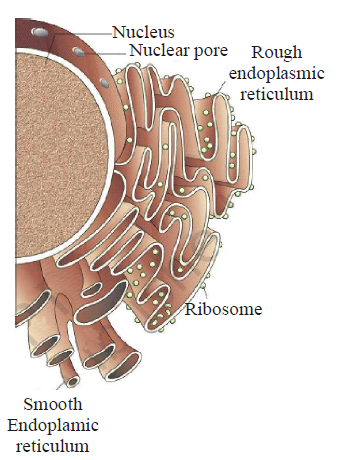
Golgi apparatus Protein synthesis
Golgi apparatus Formation of glycolipids
Rough endoplasmic reticulum Protein synthesis
Rough endoplasmic reticulum Formation of glycoproteins
Most of water, in mature plant cells occurs in
nucleus
cell wall
vacuoles
cytoplasm
Which of the following statement is false?
The ribosomes of a polysome translate the mRNA into protein.
Mitochondria divide by fragmentation.
All cell arise from pre-existing cells.
The lipid component of the membrane mainly consists of phosphoglycerides.
Cell sap is a
living content of cytoplasm.
nonliving content of cytoplasm.
nonliving content of vacuole.
living content of vacuole.
Which of the following organelles is directly connected to the outer membrane of the nucleus in a eukaryotic cell?
Mitochondrion
Lysosome
Golgi apparatus
Endoplasmic reticulum
Identify the cell organelle given below. Which is an important site of formation of glyeoproteins & glycolipids
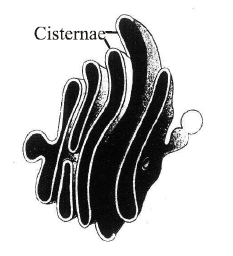
Rough endoplasmic reticulum
Smooth endoplasmic reticulum
Golgi body
mitochondria
Identify the components labelled as A, B, C, D and E in the diagram given below from the list (i) to (viii).
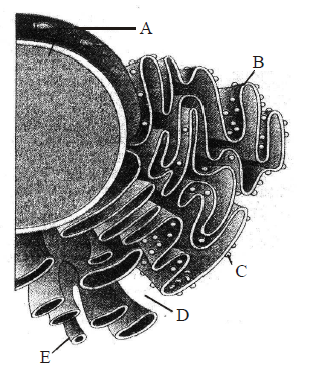
- Cristae of mitochondria
- Inner membrane of mitochondria
- Cytoplasm
- Smooth endoplasmic reticulum
- Rough endoplasmic reticulum
- Mitochondrial matrix
- Ribosome
- Nucleus
A - (viii), B - (v), C - (vii), D - (iii), E - (iv)
A - (i), B - (iv), C - (vii), D - (vi), E - (iii)
A - (vi), B - (v), C - (iv), D - (vii), E - (i)
A - (v), B - (i), C - (iii), D - (ii), E - (iv)
Which of the following is absent in prokaryotes?
DNA
RNA
Plasma membrane
Mitochondria
Which of the following cell organelles were discovered after the introduction of electron microscope?
Mitochondria
Endoplasmic reticulum
Ribosomes
Both (b) and (c)
Which of the following statements are correct ?
- In prokaryotic cells, a special membranous structure formed by the extension of the plasma membrane into the cell is known as polysome.
- The smooth endoplasmic reticulum is the major site for synthesis of glycoproteins.
- RuBisCO is the most abundant protein in the whole biosphere.
- Mitochondria, chloroplasts and peroxisomes are not considered as part of endomembrane system. Of the above statements
(iii) and (iv)
(i) and (ii)
(ii) and (iii)
(i) and (iv)
pH of vacuolar cell sap is
neutral and isotonic.
alkaline and isotonic.
acidic and hypertonic.
equal to cytoplasm and isotonic.
Match column-I (scientists) with column-II (discovery) and select the correct option.
| Column-I | Column-II |
|---|---|
| A. Leeuwenhoek | I. First saw and described a living cell |
| B. Robert Brown | II. Presence of cell wall is unique to plant cells |
| C. Schleiden | III. Discovered the nucleus |
| D. Schwann | IV. All plants are composed of different kind of cells |
A I, B III, C IV, D II
A I, B III, C II, D IV
A III, B I, C IV, D II
A I, B IV, C II, D III
Centrioles and centrosomes occur in the cells of
green plants
animals
bacteria and cyanobacteria
both (b) and (c)
Membranous extensions in blue green algae are known as
phytochrome
chromatophore
mesosome
pneumatophore
Both the membranes of mitochondrion are
structurally different but functionally similar.
structurally as well as functionally different.
structurally similar but functionally different.
structurally different but functionally similar.
Satellite means
terminal part of the chromosome beyond secondary constriction.
terminal part of the chromosome beyond primary constriction.
terminal part of chromosome beyond tertiary constriction.
none of the above
What would happen if lysosomes get ruptured in a cell?
Cell dies
Cell shrinks
Cell swell up
Nothing would happen
The following diagram shows some of the missing structures in a plant cell marked as A, B, C, D E. Choose the option with their correct names.
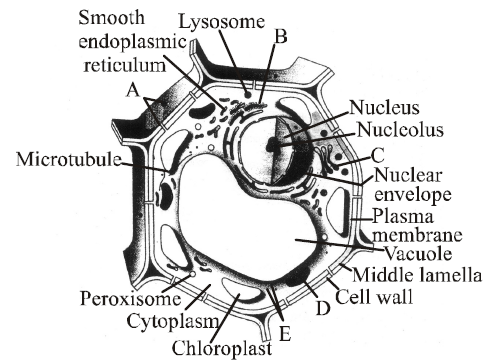
A - Plasmodesmata, B - Rough endoplasmic reticulum, C - Golgi apparatus, D - Mitochondrion, E - Ribosomes
A - Desmosome, B - Rough endoplasmic reticulum, C - Golgi apparatus, D - Mitochondrion, E - Ribosomes
A - Plasmodesmata, B - Smooth endoplasmic reticulum, C - Golgi apparatus, D - Mitochondrion, E - Ribosomes
A - Tight junction, B - Rough endoplasmic reticulum, C - Golgi apparatus, D - Mitochondrion, E -Ribosomes
8.A student was given cell samples (A and B) to identify parts which are highlighted. He observed the samples under the microscope and list down the function of the part of cell sample. The information collected by the student is listed in the table below, on the basis of which the student infers that the samples contain the organelles.
| Sample A | Sample B |
|---|---|
| Make energy available for cellular metabolism | Generates ATP and synthes izes s ugar |
| Absent in cell that carry oxygen throughout the body | Present in plant cell |
| Called the energy currency of cell | Source o f all the food energy |
Identify the part highlighted in the sample A and B and explain why they were called as semi-autonomous organelles?
Sample A - Mitochondria, Sample B - Chloroplast; because both the organelles are double membrane bound structure.
Sample A- Mitochondria, Sample B - Chloroplast; because they both are capable of synthesis of their own proteins only.
Sample A - Mitochondria, Sample B - Chloroplast; because they are capable of synthesis of their own proteins and contain their own DNA.
Sample A- Mitochondria, Sample B - Chloroplast; because they contain their own DNA to transfer the genetic information from one generation to another.
The following diagram represents a structure chromosome.
Identify the structures marked as A, B and C.
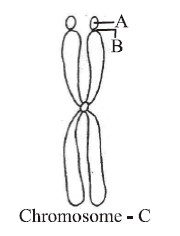
A - Satellite, B - Primary constriction, C - Acrocentric
A - Satellite, B - Secondary constriction, C - Metacentric
A - Satellite, B - Centromere, C - Telocentric
A - Satellite, B - Centromere, C - Submetacentric
Match column I (cell type) with column II (size) and choose the correct option.
| Column-I | Column-II |
|---|---|
| (Cell type) | (Size) |
| A. Viruses | I. 1-2 ??m |
| B. PPLO | II. 10-20 ??m |
| C. Eukaryotic cell | III. About 0.1 ??m |
| D. Bacterium | IV. 0.02 - 0.2 ??m |
A I, B II, C III, D IV
A IV, B III, C II, D I
A I, B III, C II, D IV
A IV, B II, C III, D I
Lysosomes contain
carbohydrates
hormones
nucleic acids
hydrolases.
Statement 1: Centrosomes and centrioles are related to each other.
Statement 2: Centrosome usually contains two cylindrical structures called centrioles.
Both statements -1 and statement - 2 are true and statement - 2 is the correct explanation of statement - 1.
Both statements -1 and statement - 2 are true but statement - 2 is not the correct explanation of statement - 1.
Statement -1 is true and statement - 2 is false.
Statement -1 is false and statement - 2 is true.
